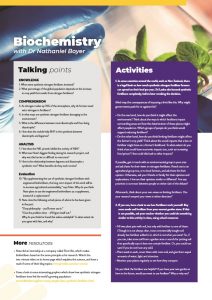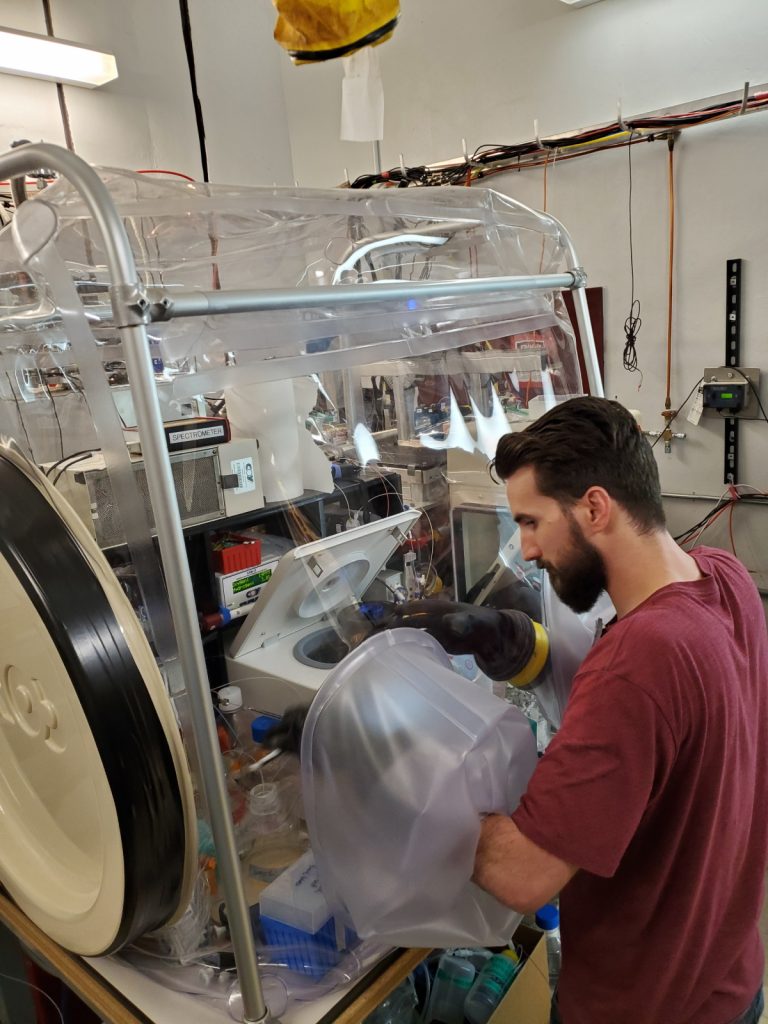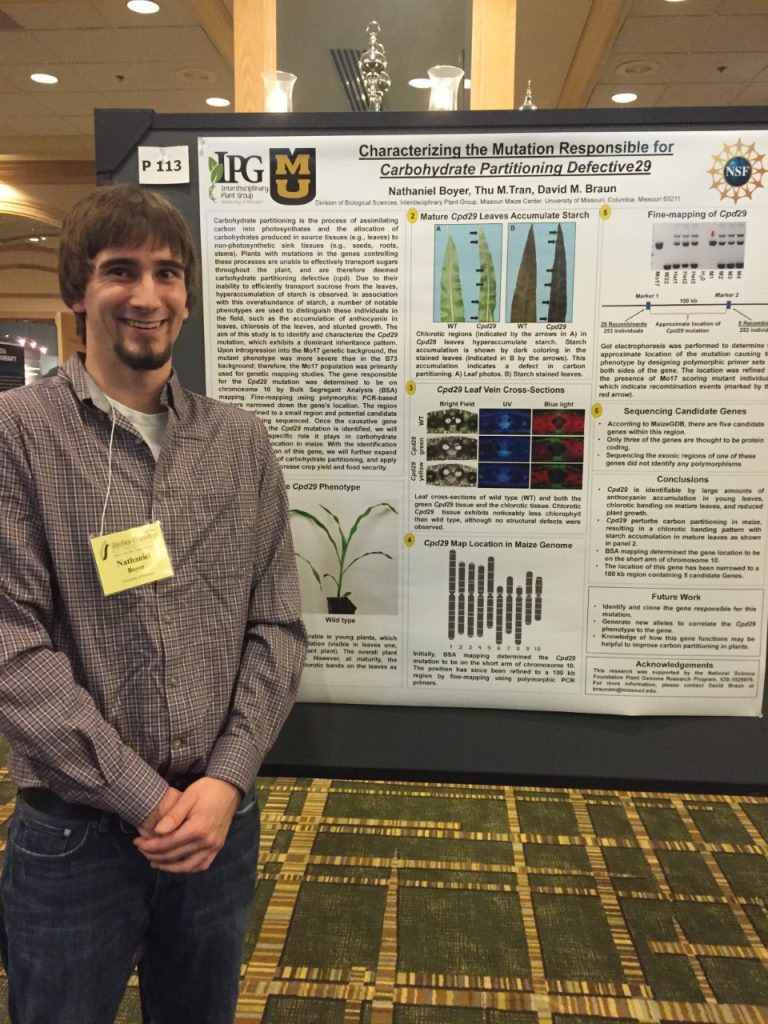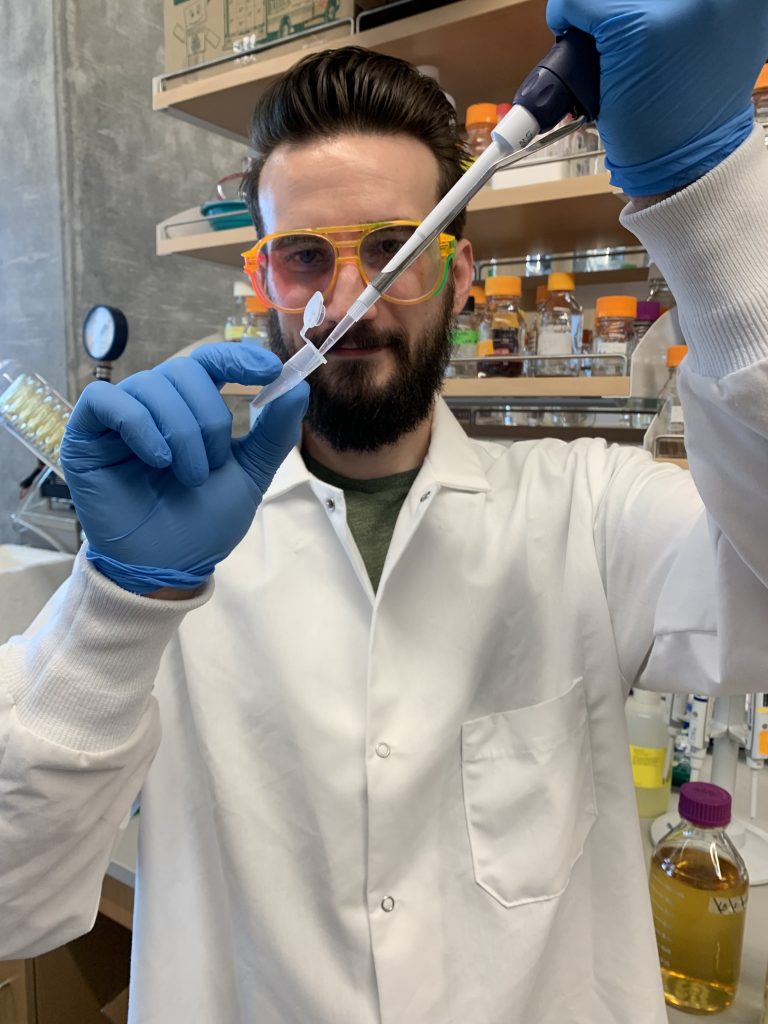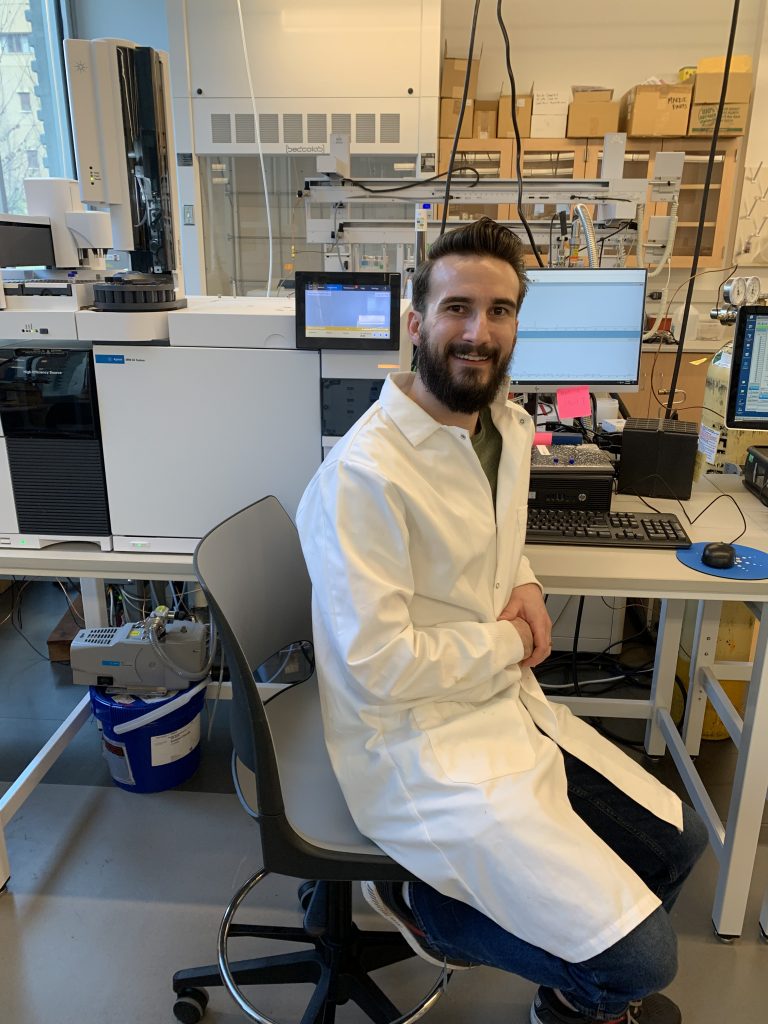Can soil microbes improve agricultural sustainability?
Synthetic fertilisers are currently necessary for producing enough food for the global population to survive, but they are known to contribute to greenhouse gas levels, contaminate water sources and increase soil acidity. At Washington State University in the US, Dr Nathaniel Boyer is a biochemist working to find a more environmentally friendly solution.
TALK LIKE A BIOCHEMIST
Biofertiliser — a fertiliser containing living microorganisms that naturally supports nitrogen fixation
Biological nitrogen fixation (BNF) — the natural process of plants converting atmospheric nitrogen into ammonia
Diazotrophs — bacteria and microorganisms that convert nitrogen gas to ammonia
Intracellular — located or occurring within a cell
Legume — a plant that has its seeds in a pod, such as a pea or bean
NifA — a protein that activates the expression of nitrogenase
NifL — a protein that inhibits the activity of NifA
Nitrogenase — an enzyme of various nitrogen-fixing bacteria that catalyses nitrogen fixation
Symbiosis — any type of interaction between two different organisms that benefits them both
Nitrogen gas makes up 78% of the Earth’s atmosphere and is crucial for life on our planet. It is found in soil, plants, water and air, is a key building block for DNA and proteins, creates chlorophyll to help plants with photosynthesis, and helps turn the plants we grow into food we can eat.
However, even though there is plenty of nitrogen gas available, it is not in a form that plants can make use of right away. Instead, it needs to be converted into nitrates, nitrites and ammonia, through a process that scientists call nitrogen fixation. This is just one part of the nitrogen cycle, which allows nitrogen to move from the atmosphere to the soil and back again.
Dr Nathaniel (Nate) Boyer is focused on the role nitrogen plays in agriculture. “Nitrogen is commonly a limiting nutrient in crop growth,” says Nate. This means that there is often not enough fixed nitrogen to allow crops to grow as much as they otherwise could.
In the early 1990s, two German scientists, Fritz Haber and Carl Bosch, found a way to convert nitrogen in the air to ammonia and so create nitrogen fertiliser that would help plants to grow. With a current world population of over 8 billion, many farmers now rely on those fertilisers to help increase crop yields so that we have enough food to eat. These fertilisers are a huge part of farming processes – in fact, it is estimated that 48% of the world’s population is fed by the increase in yield that has resulted from synthetic nitrogen fertilisers. This means that, in 2015, 3.5 billion people would have died, or would not have been born in the first place, if it were not for the invention of synthetic nitrogen fertilisers.
So, what is wrong with synthetic nitrogen fertilisers?
Unfortunately, synthetic nitrogen fertilisers cause nearly as many issues as they solve. Firstly, the process of creating these fertilisers is an extremely energy intensive one, which requires nitrogen gas to react with hydrogen under high temperatures and pressures. “This process is reliant upon fossil fuels, consuming more than 1% of our global energy supply annually, while contributing to greenhouse gas emissions,” says Nate.
As well as this, unused nitrogen fertilisers can leak into the environment, upsetting the normal balance of the nitrogen cycle and having negative consequences. “With synthetic fertilisers, most of the nitrogen is applied early in the growing season, and more than half of applied nitrogen fertilisers are washed away or evaporate before they can be used by crops,” says Nate. “This contaminates local water supplies with fertiliser run-off and emits nitrous oxide, a greenhouse gas 300 times more potent than carbon dioxide.”
Fertiliser running off into nearby water sources has led to the creation of ‘dead-zones’ – areas where little to no aquatic life can survive. On top of all this, using synthetic nitrogen fertilisers over a long period of time can also limit future crops from growing on the same land, as nitrogen fertilisers make the soil too acidic.
Is there another solution?
Nate is looking for ways to increase the input of biological nitrogen fixation (BNF) to help mitigate these issues. BNF is a natural process where microbes known as diazotrophs use the enzyme nitrogenase to convert nitrogen gas to ammonia themselves. “BNF shifts the heavy lifting to diazotrophs that live directly on crop roots, supplying nitrogen when and where crops need it throughout the growing season,” says Nate.
However, BNF is complex and only a select few organisms are capable of surviving on atmospheric nitrogen. As with the production of nitrogen fertilisers, BNF is a very high energy process. “Nitrogenase is quickly destroyed in the presence of oxygen,” says Nate. “Therefore, diazotrophs need to maintain tight control of nitrogenase expression and activity in response to the presence of intracellular oxygen in addition to cellular energy and nitrogen conditions.”
Currently, BNF in agriculture is mostly limited to legumes, as these crops have developed a close symbiotic relationship with diazotrophs, and BNF is done by diazotrophs that the legumes house in their roots. “Diazotrophs infiltrate the roots of a legume and stimulate the formation of root nodules that create an oxygen barrier to provide a suitable environment for BNF,” says Nate. This allows BNF to take place in an area without oxygen, preventing the nitrogenase from being destroyed.
BNF is beneficial for both the legume and the diazotrophs. “The legume provides carbon fixed through photosynthesis to the diazotrophs in exchange for some of the nitrogen fixed by the diazotrophs,” explains Nate.
What about plants that are not legumes?
“Some free-living diazotrophs have been demonstrated to supply nitrogen to non-legume plants,” says Nate. Free-living diazotrophs are microbes capable of supporting BNF without needing the help of another organism, such as the roots of a legume. Nate hopes to find out as much about these diazotrophs as possible so that he can develop a sustainable, environmentally friendly solution to supply nitrogen to crop plants while minimising the negative impacts of synthetic fertilisers.
“Using synthetic biology to increase BNF activity in these free-living diazotrophs has the potential to generate enhanced biofertilisers that are compatible with a wide variety of crop plants,” Nate explains.
What happens inside free-living diazotrophs?
In some of these free-living diazotrophs, nitrogenase gene expression is controlled by the interaction of two proteins, NifL and NifA (‘Nif’ stands for nitrogen fixation).
Reference
https://doi.org/10.33424/FUTURUM415
(© Richard Gillian)
(© Matt Peck)
When fixed nitrogen and oxygen levels are low, conditions are suitable for BNF and the NifA protein is active. “NifA activates the expression of nitrogenase and other genes related to BNF,” explains Nate.
In contrast, NifL inhibits the activity of NifA and therefore limits nitrogenase, too. “In response to conditions unsuitable for nitrogen fixation, the NifL protein changes shape, allowing NifL to bind to NifA, preventing the expression of genes related to BNF like an ‘off-switch’,” says Nate.
Nate’s biggest finding during this research project has been understanding the structure of NifL, as it is difficult to determine the structure of a protein that changes shape! However, now that Nate and his team understand the structure, they have lots more work to do. “We can now explore how the structure of NifL changes in response to signals of cellular oxygen, energy and fixed nitrogen, and how this ultimately affects interaction with NifA,” says Nate.
What does this mean for crops?
Nate’s research on NifL and NifA interactions shines a light on how diazotrophs control BNF and nitrogenase gene expression. Nate’s work lays the foundations for creating engineered biofertilisers that can be used on a wide variety of different crops, and which farmers can use in conjunction with synthetic nitrogen fertilisers.
“The long-term impact of this work will be to increase agricultural sustainability,” explains Nate. Hopefully, with more research like Nate’s, scientists will find ways for farmers to have high enough crop yields to feed the global population, while minimising the environmental impact.
 Dr Nathaniel Boyer
Dr Nathaniel Boyer
Institute of Biological Chemistry, Washington State University, USA
Fields of research: Molecular Plant Sciences, Biochemistry
Research project: Investigating nitrogenase expression in diazotrophs with the aim of improving crop yields in an environmentally friendly way
Funder: US Department of Agriculture (USDA)
This work is supported by Agricultural and Food Research Initiative grant no. 2021-67034-35148 from the USDA National Institute of Food and Agriculture. The content is solely the responsibility of the authors and does not necessarily represent the official views of the funding agencies.
About biochemistry
Biochemists study chemical processes and structures in animals, plants and microorganisms (such as bacteria and viruses). As well as working in medical, dental and veterinary areas, biochemical scientists can work in food science, pharmacology and agriculture. They might study anything from how an organism gets energy from food to how insecticides affect plants, to how diseases are passed down through genetics. “Biochemical research provides the opportunity to solve complex puzzles in a collaborative setting on a daily basis,” says Nate.
What research opportunities will be open to the next generation of biochemists?
“The amazing thing about research is that it’s a self-perpetuating system,” says Nate. “Our scientific understanding builds on the work of those who came before us, and the answer to any well-thought research question should allow scientists to ask more interesting questions. So, there are countless opportunities for the next generation of biochemists!”
What does a typical day look like for Nate?
“One thing that I really enjoy about research is how variable a ‘typical’ day can be,” says Nate. “I may be in the lab performing experiments, on the computer analysing data or performing computational experiments, presenting my findings, or reading to stay up to date with rapidly evolving cutting-edge techniques. Some experiments require highly specific, expensive equipment, so I often travel to other labs to collaborate with scientists from different backgrounds, which I’ve always enjoyed.”
Pathway from school to biochemistry
• If you are interested in becoming a biochemist, take classes in biology, chemistry, physics and mathematics at high school and post-16.
• “There are many great educational resources on YouTube that can help you get a basic understanding of biochemistry,” says Nate. “I watched a lot of Khan Academy videos throughout my education. As you get started, it can feel like learning a new language, and sometimes it can feel overwhelming. If you keep striving to understand the concepts, fluency will come with time.” Have a look at Khan Academy’s explanation of the nitrogen cycle.
• Study for a bachelor’s degree in biochemistry or a related field such as biology, molecular biology or biomedical engineering. However, Nate recommends choosing the classes that inspire you. “Personally, I’ve found that my degree in philosophy, focused on advanced logic and philosophy of science, has been indispensable to designing effective experimental strategies,” says Nate. “Research takes all kinds, so my best advice would be to follow your passion and keep an eye open for where your expertise fits in.”
• Try to gain laboratory experience whenever you can, such as through a summer placement at a university or an internship at a pharmaceutical company. To work in research, you will need to complete a master’s degree and a PhD after your bachelor’s degree.
• “Taking any computer science classes will position you well to make use of machine learning and other computational tools that are revolutionising the field of biochemistry,” says Nate.
• If you are a high schooler in the US and come from a Native American community, have a look at Washington State University’s ‘Exploring Emerging College Leaders’ (EXCEL) programme, which allows students to conduct their own mini biochemical project.
Explore careers in biochemistry
• The American Chemical Society has some great information on the field of biochemistry, as well as information on the differences between working in academia, industry, government or for a non-profit organisation.
• The US Bureau of Labor Statistics has a useful page on what being a biochemist involves, as well as a list of similar occupations.
• According to Payscale.com, the average annual salary for a biochemist in the US is around $70,000.
Meet Nate
Who or what inspired you to become a scientist?
I’ve always wanted to be a scientist. When I was 5 years old, my parents got my older brother a chemistry set for Christmas, and, even though I was well below the age recommendation, I was far more excited about this gift than he was. So, my parents spent a lot of time supervising me while I mixed the colourful chemicals, and ever since then, I’ve wanted to be a researcher.
Coming from a small, rural town, I didn’t really have any examples of scientists growing up, but I was fortunate to have the support of family, friends and mentors who have all encouraged me to find what I want to do and pursue it. It wasn’t until the summer after my second year at the University of Missouri that I had the opportunity to participate in research. Assuredly, I am in this position today because of the mentorship of Dr Frank Baker and Professor David Braun, who both believed in me and provided me with the opportunity to chase my curiosity.
What experiences have shaped your career path?
My biggest eureka moment, so far, was probably looking at the model of the NifL protein structure I created. To build the model, I had to bring together knowledge from 30 years of scientific literature and integrate this with newer bioinformatic techniques. It was like putting together a 5,000-piece jigsaw puzzle! The whole process took several months, but when everything fell into place, it revealed a picture that showed us so much more than we thought we knew at the time.
What has been the worst advice you have been given?
- “Drop philosophy – you’ll never use it.”
- “Give the problem time – it’ll figure itself out.”
What attributes have made you successful as a scientist?
Curiosity and persistence. I’ve always been curious about biology and what makes organisms functional and adaptable, and it’s this curiosity that pulled me in initially. Research can be slow and difficult though, and success requires persistence and hard work.
What are your proudest career achievements so far?
My proudest achievement is independently securing funding for my graduate research by applying for and being awarded the US Department of Agriculture NIFA AFRI Pre- Doctoral fellowship.
Nate’s top tips
1. Believe in yourself and don’t be afraid to fail. When I graduated high school, I honestly didn’t think I was capable of understanding chemistry, and the fear of failure associated with this delayed me from pursuing a position in research. You’re capable of more than you think you are.
2. Follow your passion. Success requires hard work, but if you follow your passion, the work will be fun along the way.
Do you have a question for Nate?
Write it in the comments box below and Nate will get back to you. (Remember, researchers are very busy people, so you may have to wait a few days.)


